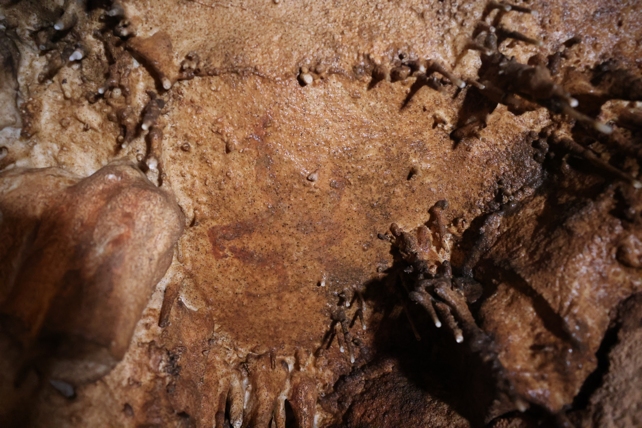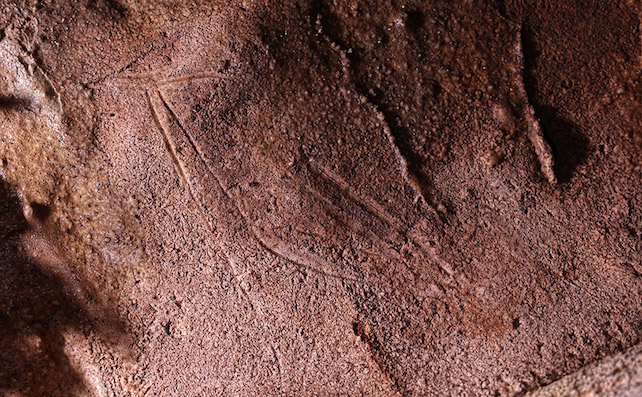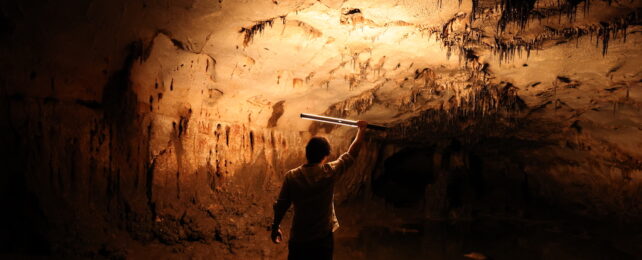For the past 24,000 years or so, a hidden sanctuary of Paleolithic rock art has endured on the walls of a cave near Valencia in eastern Spain, holding clues about the ancient artists and the world they inhabited.
The cave itself is well-known to locals and spelunkers yet more than 110 paintings and engravings went overlooked until June 2021, when researchers from the University of Zaragoza and University of Alicante in Spain found them about 400 meters from the cave entrance.
It's a big deal to discover any remnants of prehistoric art, but this cave may provide especially valuable clues about Paleolithic people and their environment.
Located at a site called Cova Dones near Spain's Mediterranean coast, the cave holds a wealth of well-preserved rock art made by humans more than 24,000 years ago, the study's authors report, including at least 19 portrayals of wildlife.

In addition to several horses and red deer (plus a pair of unidentified animals), the researchers found two depictions of aurochs – an extinct bovine species believed to be the ancestor of modern cattle.
"When we saw the first painted auroch, we immediately acknowledged it was important," says study co-author Aitor Ruiz-Redondo, senior lecturer of prehistory at the University of Zaragoza in Spain and research affiliate at the University of Southampton in the U.K.
The abundance and variety of Paleolithic art in this cave is rare for Eastern Iberia, he adds, which generally lacks the dramatic galleries of ancient cave paintings found in nearby regions to the north.
"Although Spain is the country with the largest number of Paleolithic cave art sites, most of them are concentrated in northern Spain," Ruiz-Redondo says. "Eastern Iberia is an area where few of these sites have been documented so far."
And while that first auroch hinted at the cave's importance, only upon further investigation did the researchers grasp the magnitude of what they had found.
"However, the actual shock of realizing its significance came long after the first discovery," Ruiz-Redondo says. "Once we began the proper systematic survey, we realized we were facing a major cave art site, like the ones that can be found elsewhere in Cantabrian Spain, southern France or Andalusia, but that totally lack in this territory."
The Franco-Cantabrian region is home to more than 70 percent of all known Paleolithic cave art sites, the researchers point out, although recent years have seen new discoveries elsewhere in Europe and in Asia, offering a broader view of the Late Pleistocene art scene.
Eastern Iberia does have several known Pleistocene cave art sites, they add, but they tend to be sparsely distributed and rarely include painted figures, of which only three were previously known across the region.
That makes it all the more surprising – and intriguing – to find this array of cave art in this part of the Iberian Peninsula, hinting at how much we have yet to learn about human culture and symbolism in the Paleolithic.
The site at Cova Dones features a single gallery cave about 500 meters deep, the study's authors write, and despite some previous discoveries there dating from the Iron Age, there were no hints of Paleolithic people until Ruiz-Redondo and his colleagues began looking in 2021.

They've found 110 distinct graphical units in three zones of the cave, with a diversity of motifs and artistic methods suggesting it may be one of the most important sites for rock art on the Iberian Peninsula's Mediterranean coast, the researchers write.
It may even represent the highest total of Paleolithic motifs found at any cave in Europe since 2015, when archaeologists exploring Atxurra cave also discovered a trove of paintings and engravings, many depicting animals.
The cave at Cova Dones includes engravings done in a typical outline style, the researchers report, but the artists also shaded some of the figures by scraping limestone precipitate against the walls, a technique that's reportedly rare in Paleolithic cave art and unheard of in Eastern Iberia.
The cave's paintings are unusual, too, since most were made with iron-rich red clay instead of the more common diluted ochre or manganese powder.
"Animals and signs were depicted simply by dragging the fingers and palms covered with clay on the walls," Ruiz-Redondo says.
"The humid environment of the cave did the rest: The paintings dried quite slowly, preventing parts of the clay from falling down rapidly, while other parts were covered by calcite layers, which preserved them until today."
This kind of clay painting technique is only rarely found in Paleolithic cave art, the researchers note, yet it's apparently the primary method used by the prehistoric painters of Cova Dones.
Work at Cova Dones is far from finished, the authors add, with more art left to be documented and more areas of the cave still waiting to be surveyed.
The study was published in Antiquity.
